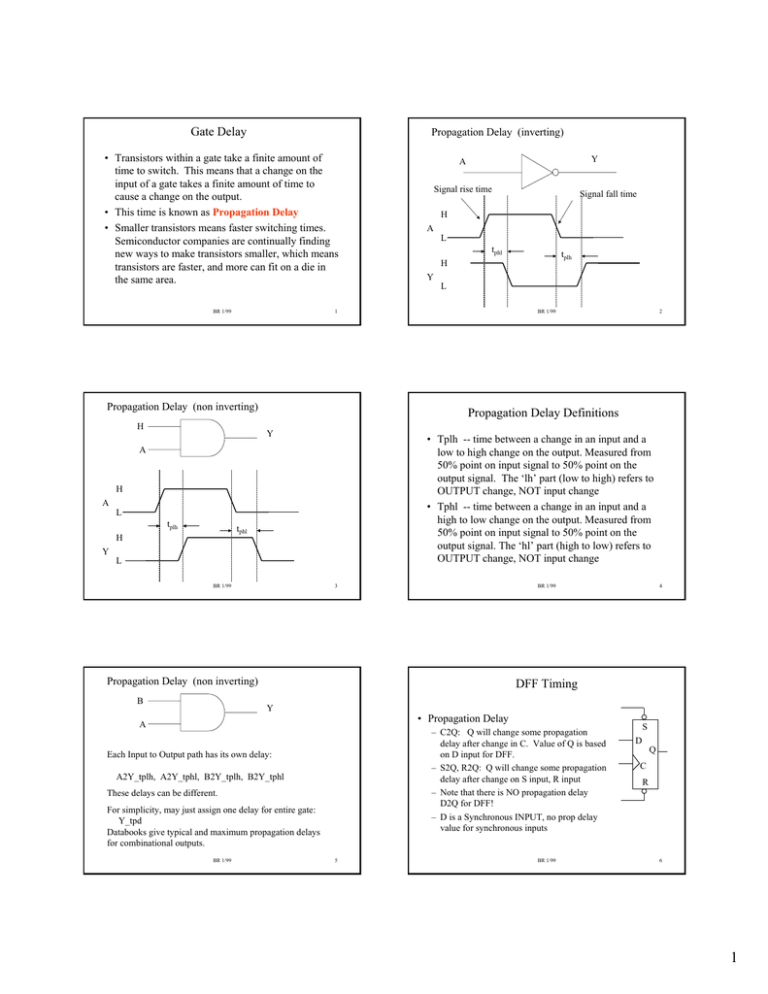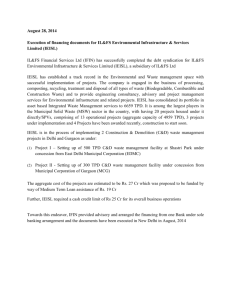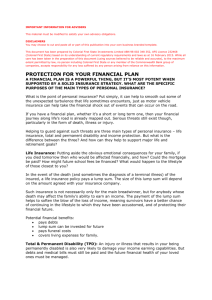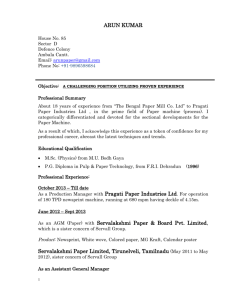Gate Delay Propagation Delay Definitions DFF Timing
advertisement

Gate Delay Propagation Delay (inverting) • Transistors within a gate take a finite amount of time to switch. This means that a change on the input of a gate takes a finite amount of time to cause a change on the output. • This time is known as Propagation Delay • Smaller transistors means faster switching times. Semiconductor companies are continually finding new ways to make transistors smaller, which means transistors are faster, and more can fit on a die in the same area. BR 1/99 H Y Y H A L tphl L tphl L BR 1/99 Y L BR 1/99 3 4 DFF Timing Y • Propagation Delay A – C2Q: Q will change some propagation delay after change in C. Value of Q is based on D input for DFF. – S2Q, R2Q: Q will change some propagation delay after change on S input, R input – Note that there is NO propagation delay D2Q for DFF! – D is a Synchronous INPUT, no prop delay value for synchronous inputs Each Input to Output path has its own delay: A2Y_tplh, A2Y_tphl, B2Y_tplh, B2Y_tphl These delays can be different. For simplicity, may just assign one delay for entire gate: Y_tpd Databooks give typical and maximum propagation delays for combinational outputs. BR 1/99 2 BR 1/99 Propagation Delay (non inverting) B tplh H • Tplh -- time between a change in an input and a low to high change on the output. Measured from 50% point on input signal to 50% point on the output signal. The ‘lh’ part (low to high) refers to OUTPUT change, NOT input change • Tphl -- time between a change in an input and a high to low change on the output. Measured from 50% point on input signal to 50% point on the output signal. The ‘hl’ part (high to low) refers to OUTPUT change, NOT input change H tplh Signal fall time Propagation Delay Definitions A H Signal rise time 1 Propagation Delay (non inverting) A Y A 5 BR 1/99 S D Q C R 6 1 Setup, Hold Time Setup, Hold Times tsu thd • Synchronous inputs (e.g. D) have Setup, Hold time specification with respect to the CLOCK input • Setup Time: the amount of time the synchronous input (D) must be stable before the active edge of clock • Hold Time: the amount of time the synchronous input (D) must be stable after the active edge of clock. C Stable D changing D changing If changes on D input violate either setup or hold time, then correct FF operation is not guaranteed. Setup/Hold measured around active clock edge. BR 1/99 7 BR 1/99 Sequential System Timing Longest Paths in Sequential System Diagram m n Combinational Logic Circuit k-bit Present State Value k DFF Q D Paths to check: k-bit Next State Value A. Clock to Output delay: Tc2q + Tcomb_Q2O max Tcomb_Q2O is longest path from Q output to any output k clk B. Register to Register delay: Tc2q + Tcomb_Q2D max + Tsetup Tcomb Q2D is longest path from Q dff output to D dff input Question: What is the MAXIMUM frequency of operation of this system? C. Pin to Pin combinational delay: Tcomb_I2O max (input pin to output pin, no intervening registers) Maximum Frequency = 1/ (longest delay path) What are longest paths??? Typically, path “B” is the worst case. BR 1/99 9 BR 1/99 Inputs/Outputs Registered Tsetup D Q C N Combinational Logic Tpd max K Thold N D Q C D 10 Hold Time and Shortest Paths Very often, all inputs and outputs are registered. Then registerto-register delay will almost always determine maximum frequency. N 8 Q C N Combinational Logic Tpd min K D Q C K C2Q K To satisfy hold time: C2Q Tc2q + Tpd (minimum) >= Thold delay = Tc2q + Tpd max + Tsetup BR 1/99 This is normally easily satisfied in a sequential system. 11 BR 1/99 12 2 Toggle Frequency Setup, Hold Time for External Inputs assume wire delay is neglible External inputs are buffered through pad drivers and may go through combinational logic before they reach a synchronous input. This buffering adds propagation delay. How does this propagation delay affect the EXTERNAL setup and hold time???? What about setup time? DIN Thd, Tsu Comb Log CLK Comb Log toggle frequency = 1 /(C2Q + Tsetup) D Q C 0 Tc2q + Tpd (min) >= Thold Tcq > Thold BR 1/99 13 Tpd DIN Comb Log Q CLK C Tpd Clk D Comb Log Q C Worst case hold time for DIN occurs when ‘CLK’ is DELAYED relative to DIN. Means clock edge arrives late, requiring DIN to hold its value longer. Din Setup = Tsu + Tpd DIN (max) - Tpd CLK (min) Din Hold = Thd + Tpd CLK (max) - Tpd DIN (min) BR 1/99 15 A Timing Example U7 7 ns U1 U2 D Q U4 C BR 1/99 16 Timings U5 1 ns D ASIC Tsu Comb Log Tpd Clk Worst case setup time for DIN occurs when ‘DIN’ is DELAYED relative to CLK. Means clock edge arrives early, requiring DIN to be ready sooner. A 14 Tpd DIN DIN D C Calculating External Hold times ASIC Tsu CLK Y Q BR 1/99 Calculating External Setup times Comb Log D What is Thd, Tsu for DIN? It is NOT the same as for Thd, Tsu of the internal D FF!!!!!!! Thd, Tsu for DIN is specified in the DATASHEET for design. assuming zero wire delay DIN ASIC Thd, Tsu 9 ns U6 Y Max Register to Register Delay U2 Tc2q + U3 Tpd + U1 Tsu = 5 + 8 + 3 = 16 ns. 6 ns A setup time = Tsu + A2D Tpd max - Clk Tpd min = Tsu + (Tpd U3 + Tpd U7) - Tpd U8 = 3 + (8 + 1) - 2 = 10 ns Q C DFFs : CK U8 U3 Tsu = 3 ns Thd = 4 ns Tc2q = 5 ns 8 ns 2 ns BR 1/99 A hold time = Thd + Clk Tpd max - A2D Tpd min = Thd + Tpd U8 - (Tpd U4 + Tpd U7) = 4 + 2 - (7 + 1) = -2 ns 17 BR 1/99 18 3 Timings (Cont) DataSheet Clock to Out = U8 Tpd + U2 Tc2q + U5 Tpd + U6 Tpd = 2 + 5 + 9 + 6 = 22 ns Parameter Tclk Fclk Atsu Athd A2Y Ck2Y Pin to Pin Combinational Delay (A to Y) = U7 Tpd + U5 Tpd + U6 Tpd = 1 + 9 + 6 = 16 ns Max Clock Freq = 1/ Max (Reg2reg, Clk2Out, Pin2Pin) = 1/ Max (16, 22, 16) = 45.5 Mhz 19 D Q U4 C CK U8 U3 U2 D U6 Q U9, DFF C DFFs : Tsu = 3 ns Thd = 4 ns Tc2q = 5 ns 2 ns BR 1/99 21 New DataSheet Parameter Tclk Fclk Atsu Athd Description Clock Period Clock Frequency A setup time A hold time Ck2Y Clock to Y tpd 16 22 20 Max Register to Register Delay U2 Tc2q + U5 Tpd + U9 Tsu = 5 + 9 + 3 = 17 ns. A setup time = Tsu + A2D Tpd max - Clk Tpd min = Tsu + (Tpd U7) - Tpd U8 = 3 + (1) - 2 = 2 ns A hold time = Thd + Clk Tpd max - A2D Tpd min = Thd + Tpd U8 - (Tpd U7) = 4 + 2 - ( 1) = 5 ns BR 1/99 22 How does a PLL/DLL help? Min 17 Max 58.8 2 5 13 Units ns Mhz ns ns ns • A Phased Locked Loop or Delay Locked Loop circuit is used to align the external clock edge at the pin with the internal clock edges at the DFF clk pins – Some clock skew due to clock routing network from PLL will still be present, but input buffer delay eliminated. • This means that we can drop out the Clk Tpd term from the equations • How does this change things? Most designs have all inputs, outputs registered. BR 1/99 Y 6 ns 9 ns 8 ns 45.5 10 -2 Units ns Mhz ns ns ns ns New Timings U5 7 ns U1 Max BR 1/99 How do we improve timings? U7 Min 22 Negative hold times are typically specified as 0 ns. BR 1/99 Register all Inputs, Outputs! 1 ns U8, DFF A Description Clock Period Clock Frequency A setup time A hold time A to Y Tpd Clock to Y tpd 23 BR 1/99 24 4 Without PLL With PLL Buffer Delay Buffer Delay eliminated ExtCK ExtCK IntCK IntCK D D Q C D Q P L L C ExtCK ExtCK IO Buffer Delay IntCK 25 IntCK NO pin to Pin combinational delay! All inputs/outputs registered! Max Clock Freq = 1/ Max (Reg2reg, Clk2Out, Pin2Pin) = 1/ Max (17, 11, 0) = 58.8 Mhz A hold time = Thd + Clk Tpd max - A2D Tpd min = Thd + 0 (due to PLL) - (Tpd U7) = 4 + 0 - ( 1) = 3 ns BR 1/99 27 BR 1/99 New DataSheet (PLL, Inputs/Outputs Reg) Min 17 Max 58.8 4 3 11 26 Clock to Out = U8 Tpd + U9 Tc2q + U6 Tpd = 0 (due to PLL) + 5 + 6 = 11 ns A setup time = Tsu + A2D Tpd max - Clk Tpd min = Tsu + (Tpd U7) - 0 (due to PLL) = 3 + (1) - 0 = 4 ns Clock to Y tpd Q C New Timings (PLL, Inputs/Outputs Reg) Max Register to Register Delay U2 Tc2q + U5 Tpd + U9 Tsu = 5 + 9 + 3 = 17 ns. Ck2Y C BR 1/99 New Timings (PLL, Inputs/Outputs Reg) Description Clock Period Clock Frequency A setup time A hold time D IO Buffer Delay BR 1/99 Parameter Tclk Fclk Atsu Athd Q 28 Chip to Chip Timing Calculation Units ns Mhz ns ns Inputs ns ASIC #1 ASIC #2 CLK Clock to Output improved; important in multiple chip designs. External Setup/Hold times closer to setup/hold times of internal DFFs. Need to know external setup/hold times all inputs, clk to out of all outputs, all pin to pin combinational delays. ASIC = Application Specific Integrated Circuit BR 1/99 29 BR 1/99 30 5 Max Register to Register Delay 2 ASIC System Other Factors that effect Timing Assume no pin to pin combinational delays and that inputs/outputs of both ASICs are registered. For any outputs from ASIC #1 which are Inputs to ASIC #2 find maximum of ASIC #1 Clk to out + ASIC#2 Setup time. For any outputs from ASIC #2 which are Inputs to ASIC #1 find maximum of ASIC #2 Clk to out + ASIC#1 Setup time. The maximum of these two times will be the minimum clock period. BR 1/99 • Voltage: the higher the voltage, the faster that gates switch • Temperature: the lower the temperature, the faster that gates switch • Process Technology (transistor gate width). The shorter the transistor gate length, the faster the transistor will switch (I.e, 0.5u process versus 0.35u process). • In a given process run, may get fast N transistors, fast P transistors, slow N transistors, slow P transitors 31 BR 1/99 Speed Grades Device Characterization • Do timing analysis on ASICs at four extreme corners to make sure they meet timing specs under all conditions • Fastest Case: Fast N transistors, Fast P transistors, High Vdd, Low temperature • Slowest Case: Slow N transistors, slow P transistors, low Vdd, high temperature • Other two corners can vary but two possible corners are: – Fast N, Slow P, Typical Temperature – Slow N, Fast P, Typical Temperature BR 1/99 32 33 • Databooks often list different speed grades for a part at the same temperature • Simply test parts that come off the fabrication line and see how fast they are – Divide the parts into different speed bins – For three speed grades, a design goal might be to have 15% of your parts fall in the upper bin, 50% in the middle bin, and 25% in the lower bin. – As the process matures, more and more fabricated parts will move into the upper speed bin, at which point you make a new upper speed bin. – Obviously, faster parts cost more (and are more profitable) BR 1/99 34 Static Path Analysis Static Timing Analysis Reports • After your gate netlist has been mapped to the FPGA, a timing analysis tool will analyze the paths in the design and compute the timings we have discussed • The timing analyzer takes into account the routing delays in the physical routing and the speed grade of the part you have mapped to. • The static timing analyzer will report the following times – Because routing can sometimes change somewhat drastically for even small changes, often try run multiple device mappings to try to get a ‘good route’. BR 1/99 35 – – – – Register to Register delays Setup times of all external synchronous inputs Clock to Output delays Pin to Pin combinational delays • The clock to output delay is usually just reported as simply another pin-to-pin combinational delay • Timing analysis reports are often pessimistic since they use worst case conditions BR 1/99 36 6 Timing Simulation • The timings extracted by the Timing analysis tool (routing delays, gate delays for a particular speed grade, etc) are used in the simulation • It may be tempting to simply ignore the delays reported by the timing analyzer, and simply simulate the design ‘at speed’ to see if it works. – If the design simulates correctly, only means that it works for the particular test vectors that you used! – Different test vectors exercise different delay paths - you must use test vectors that exercise the LONGEST paths BR 1/99 37 7



